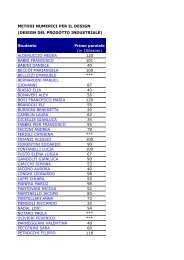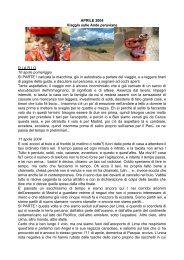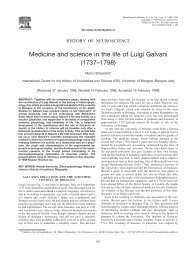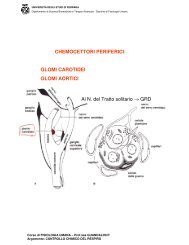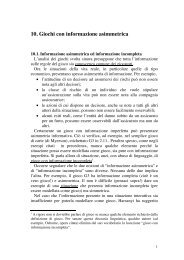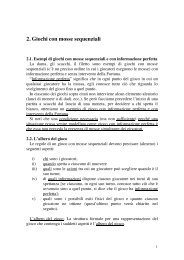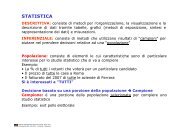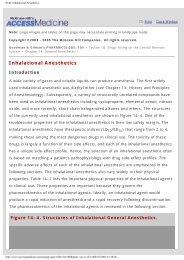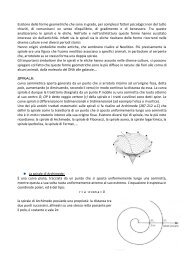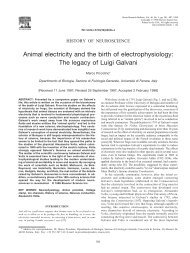EMERGENCY MEDICINE PRACTICE La sedazione per le ... - utenti
EMERGENCY MEDICINE PRACTICE La sedazione per le ... - utenti
EMERGENCY MEDICINE PRACTICE La sedazione per le ... - utenti
You also want an ePaper? Increase the reach of your titles
YUMPU automatically turns print PDFs into web optimized ePapers that Google loves.
13. Rocke DA, Rout CC, Gouws E. Intravenous administration<br />
of the proton pump inhibitor omeprazo<strong>le</strong> reduces the risk<br />
of acid aspiration at emergency cesarean section. Anesth<br />
Analg 1994;78:1093-1098. (Studio randomizzato, in doppio<br />
cieco; 541 pazienti)<br />
14. Mellin-Olsen J, Fasting S, Gisvold SE. Routine preo<strong>per</strong>ative<br />
gastric emptying is seldom indicated. A study of 85,594<br />
anaesthetics with special focus on aspiration pneumonia.<br />
Acta Anaesthesiol Scand 1996;40:1184-1188. (85.594 procedure)<br />
15. Avramov MN, White PF. Methods for monitoring the <strong>le</strong>vel<br />
of sedation. Crit Care Clin 1995;11(4):803-826. (Review)<br />
*16. Council on Scientific Affairs, American Medical Association.<br />
The use of pulse oximetry during conscious sedation.<br />
JAMA 1993;270(12):1463-1468. (Review)<br />
17. Wright SW. Conscious sedation in the emergency department:<br />
the value of capnography and pulse oximetry [see<br />
comments]. Ann Emerg Med 1992;21(5):551-555. (Studio prospettico,<br />
non randomizzato, non in cieco, non controllato;<br />
27 pazienti)<br />
18. Sacchetti A, Lichenstein R, Carraccio CA, et al. Family<br />
member presence during pediatric emergency department<br />
procedures. Pediatr Emerg Care 1996;12(4):268-271. (Studio<br />
prospettico; 96 pazienti)<br />
19. Murphy MF. Sedation. Ann Emerg Med 1996;27(4):461-463.<br />
(Review)<br />
20. Ramsay MAE, Savage TM, Simpsom BRJ, Goodwin R. Control<strong>le</strong>d<br />
sedation with alphaxalone-alphadolone. Br Med J<br />
1974;2:656-659.<br />
21. Chernik DA, Gillings D, <strong>La</strong>ine H, et al. Validity and reliability<br />
of the Observer‘s Assessment of A<strong>le</strong>rtness/Sedation<br />
Sca<strong>le</strong>: Study with intravenous midazolam. J Clin Psychopharmacol<br />
1990:10;244-251. (Studio comparativo, in doppio<br />
cieco; 18 pazienti)<br />
22. Nordt SP, Clark RF: Midazolam: a review of therapeutic<br />
uses and toxicity. J Emerg Med 1997;15:357-365. (Review)<br />
23. Bai<strong>le</strong>y PL, Moll JWB, Pace NL. Respiratory effects of midazolam<br />
and fentanyl: Potent interaction producing hypoxemia<br />
and apnea. Anesthesiology 1988;169:813.<br />
24. Bai<strong>le</strong>y PL, Pace NL, Ashburn MA, et al. Frequent hypoxemia<br />
and apnea after sedation with midazolam and fentanyl.<br />
Anesthesiology 1990;73:826-830. (12 pazienti)<br />
25. Co<strong>le</strong> SG, Brozinsky S, Isenberg JI. Midazolam, a new more<br />
potent benzodiazepine, compared with diazepam: a randomized,<br />
doub<strong>le</strong>-blind study of preendoscopic sedatives.<br />
Gastrointest Edosc 1983;3:219-222. (Studio comparativo, randomizzato,<br />
in doppio cieco; 40 pazienti)<br />
26. Coughlin MW, Panuska HJ. Direct comparison of midazolam<br />
and diazepam for conscious sedation in outpatient oral<br />
surgery. Anesth Prog 1989;36:150-168.<br />
27. Wright SW, Chudnofsky CR, Dronen SC, et al. Comparison<br />
of midazolam and diazepam for conscious sedation in the<br />
emergency department. Ann Emerg Med 1993;22:201-205.<br />
(Studio prospettico, randomizzato, in doppio cieco, multicentrico;<br />
69 pazienti)<br />
28. Van Houten JS, Crane SA, Janardan SK, et al. A randomized,<br />
prospective, doub<strong>le</strong>-blind comparison of midazolam<br />
(Versed) and emulsified diazepam (Dizac) for opioid-based,<br />
conscious sedation in endoscopic procedures. Am J<br />
Gastroenterol 1998;93:170-174. (Studio prospettico, randomizzato,<br />
in doppio cieco; 211 pazienti)<br />
29. McMillan CO, Spahr-Schopfer IA, Sikich N, et al. Premedication<br />
of children with oral midazolam [see comments]. Can<br />
J Anaesth 1992;39(6):545-550. (Studio randomizzato, in doppio<br />
cieco, in controllo con placebo; 80 pazienti)<br />
30. Massanari M, Novitsky J, Reinstein LJ. Paradoxical reactions<br />
in children associated with midazolam use during<br />
endoscopy. Clin Pediatr (Phila) 1997;36(12):681-684. (2617<br />
pazienti)<br />
*31. Zink BJ, Darf<strong>le</strong>r K, Salluzzo RF, et al. The efficacy and<br />
safety of methohexital in the emergency department [see<br />
comments]. Ann Emerg Med 1991;20(12):1293-1298. (Serie<br />
consecutiva di casi; 102 pazienti)<br />
32. Swanson ER, Seaberg DC, Mathias S: The use of propofol<br />
for sedation in the emergency department. Acad Emerg Med<br />
1996;3:234-238. (Studio prospettico; 20 pazienti)<br />
33. Jastak JT, Pallasch T. Death after chloral hydrate sedation:<br />
report of case. J Am Dent Assoc 1988;116(3):345-348. (Caso<br />
clinico; 1 paziente)<br />
34. Granoff DM, McDaniel DB, Borkowf SP. Cardiorespiratory<br />
arrest following aspiration of chloral hydrate. Am J Dis<br />
Child 1971;122(2):170-171.<br />
35. D’Agostino J, Terndrup TE: Chloral hydrate versus midazolam<br />
for sedation of children for neuroimaging: A randomized<br />
clinical. Pediatr Emerg Care 2000;16:1-4. (Studio prospettico,<br />
randomizzato, in doppio cieco; 40 pazienti)<br />
36. Ganapathy S, Herrick IA, Gelb AW, et al. Propofol patientcontrol<strong>le</strong>d<br />
sedation during hip or knee arthroplasty in<br />
elderly patients. Can J Anaesth 1997;44:385-389. (Studio<br />
comparativo, randomizzato, controllato; 40 pazienti)<br />
37. Heiman DR, Tolliver BA, Weis FR, et al. Patient-control<strong>le</strong>d<br />
anesthesia for colonoscopy using propofol: results of a pilot<br />
study. So Med J 1998;91:560-564. (Studio pilota; 20 pazienti)<br />
38. Herrick IA, Gelb AW, Tseng PS, et al. Patient-control<strong>le</strong>d<br />
sedation using propofol during interventional neuroradiologic<br />
procedures. J Neurosurg Anesthesiol 1997;9:237-241.<br />
(Studio prospettico, randomizzato; 24 procedure)<br />
39. Irwin MG, Thompson N, Kenny GN. Patient-maintained<br />
propofol sedation. Assessment of a target-control<strong>le</strong>d infusion<br />
system. Anaesthesia 1997;52:525-530. (36 pazienti)<br />
40. Johns FR, Ziccardi VB, Buck<strong>le</strong>y M. Methohexital infusion<br />
technique for conscious sedation. J Oral Maxillofac Surg<br />
1996;54:578-581. (20 pazienti)<br />
41. Osborne GA, Rudkin GE, Jarvis DA, et al. Intra-o<strong>per</strong>ative<br />
patient-control<strong>le</strong>d sedation and patient attitude to control.<br />
A crossover comparison of patient preference for patientcontrol<strong>le</strong>d<br />
propofol and propofol by continuous infusion.<br />
Anaesthesia 1994;49:287-292. (Studio comparativo, randomizzato;<br />
38 pazienti)<br />
42. Rodrigo C, Chow KC. A comparison of 1- and 3-minute<br />
lockout <strong>per</strong>iods during patient-control<strong>le</strong>d sedation with<br />
midazolam. J Oral Maxillofac Surg 1995;53:406-410. (Studio<br />
comparativo, randomizzato, controllato; 38 pazienti)<br />
43. Roseveare C, Seavell C, Patel P, et al. Patient-control<strong>le</strong>d sedation<br />
and analgesia, using propofol and alfentanil, during<br />
colonoscopy: a prospective randomized control<strong>le</strong>d trial.<br />
Endoscopy 1998;30:768-773. (Studio prospettico; 66 pazienti)<br />
44. Roseveare C, Seavell C, Patel P, et al. Patient-control<strong>le</strong>d<br />
sedation with propofol and alfentanil during colonoscopy:<br />
a pilot study. Endoscopy 1998;30:482-483. (16<br />
pazienti)<br />
45. Sim KM, Hwang NC, Chan YW, et al. Use of patient-control<strong>le</strong>d<br />
analgesia with alfentanil for burns dressing procedures:<br />
a preliminary report of five patients. Burns<br />
1996;22:238-241. (Casi clinici; 5 pazienti)<br />
46. Chuang E, Wenner WJ Jr, Piccoli DA, et al. Intravenous<br />
sedation in pediatric up<strong>per</strong> gastrointestinal endoscopy.<br />
Gastrointest Endosc 1995;42(2):156-160. (Studio retrospettivo;<br />
614 pazienti)<br />
*47. Reappraisal of lytic cocktail/demerol, phenergan, and thorazine<br />
(DPT) for the sedation of children. American Academy<br />
of Pediatrics Committee on Drugs. Pediatrics<br />
1995;95:598-602. (linee guida pratiche)<br />
48. Notini-Gudmarsson AK, Dolk A, Jakobsson J, et al. Nitrous<br />
oxide: a valuab<strong>le</strong> alternative for pain relief and sedation<br />
during routine colonoscopy. Endoscopy 1996;28:283-287.<br />
(Studio randomizzato, controllato; 38 pazienti)<br />
*49. Green SM, Rothrock SG, Lynch EL, et al. Intramuscular<br />
ketamine for pediatric sedation in the emergency department:<br />
safety profi<strong>le</strong> in 1,022 cases. Ann Emerg Med<br />
1998;31:688-697. (Serie di casi clinici consecutivi; 1022 casi)<br />
50. Pruitt JW, Goldwasser MS, Sabol SR, et al. Intramuscular<br />
ketamine, midazolam, and glycopyrrolate for pediatric<br />
sedation in the emergency department. J Oral Maxillofac<br />
Surg 1995;53:13-17. (Studio prospettico; 37 pazienti)<br />
51. Qureshi FA, Mellis PT, McFadden MA. Efficacy of oral<br />
ketamine for providing sedation and analgesia to children<br />
requiring laceration repair. Pediatr Emerg Care 1995;11:93-97.<br />
(Studio prospettico, in doppio cieco, controllato con place-<br />
Emergency Medicine Practice 18<br />
Settembre 2000



